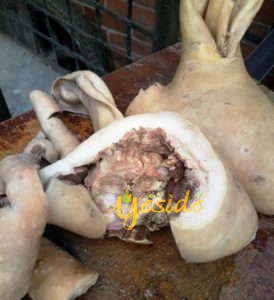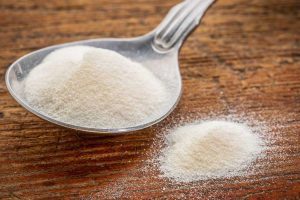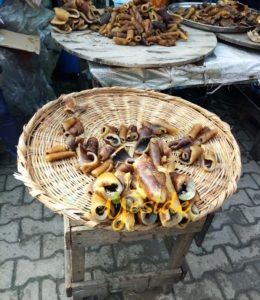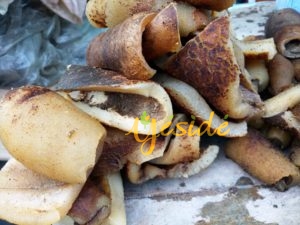
What is inside the Ponmo, Cow skin/hide that we eat?
A lot of people over time have pondered about what exactly is inside it. In times past, we were told that it contains nothing useful. But Ponmo contains something useful for the body.
100g of boiled, thick cow skin contains about 224.65kcal of energy, 6.80g of carbohydrate, about 43.9g of water, 46.9g of protein, 1.09g of fat, and 0.02g of fibre. For micronutrients, it contains small amounts of calcium (61mg), iron (4.3mg), magnesium (12mg), phosphorus (36mg) and Zinc (6.79mg).

So, Ponmo actually contains something and contributes something to your diets.
Let us look at the quality of what it contributes. Cow skin, Ponmo, contains a lot of collagen. When rating protein, the amino acid (building blocks of protein) profile is often looked at. When comparing Ponmo to lean beef, beef takes the prize in quality of protein.

Collagen when cooked forms gelatin. Gelatin is also called hydrolyzed collagen and it contains at least eight essential amino acids along with other non-essential amino acids. However, it does not contain all essential amino acids. It is therefore regarded as having lower biological value. For muscle meat, it contains all essential amino acids.

Collagen is the most abundant protein in our bodies. Because our bodies produce collagen, it is not essential that we must eat collagen for growth. However, as we grow older, our ability to produce collagen reduces leading us to have wrinkles. Eating too much sugar or refined carbohydrates (white flour, white rice), Smoking and ultraviolet rays from the sun also reduces our ability to produce collagen.
While there has been a lot to say about countries like Nigeria “eating their shoes”, interestingly, there has also been an increase in promotion of collagen supplements on the internet and drug shops. Some of these supplements are made from animal skins and animal parts containing collagen.

Collagen is widely being promoted for rejuvenating skin, improving hair, building muscle mass, improving skin elasticity, and reducing pain caused by arthritis. There are a few scientific studies that back up these claims.
You decide: Ponmo for your Shoe or Ponmo for better skin health?
The downside of eating Ponmo has to do with:
- Cow skin diseases
- Chemicals and waste materials in cow skin
- Processing of cow skin/hide for eating
Okiei et al 2009 was able to determine that there were some toxic metals in fire burnt ponmo (singeing). Ekenma et al 2015 also determined this and reported that the unacceptable presence of these toxic chemicals could be as a result of the raring, environmental factors as well singeing.

Cow skin that is boiled and skin scrapped to remove hair is purportedly better than those singed by firewood, spent engine or spent tyres. The singed Ponmo (that usually has the brown smoked look) is reported to contain more Polycyclic Aromatic Hydrocarbons (PAH), benzene and dioxins which are all culprits in cancer formation. You will also find PAH in smoked fish, roasted plantains (and generally foods that have contact with naked flames).
Oko and Okoye 2017 also reported that the difference in total PAH content of singed and non-singed Ponmo was not significant. While this is a recent study, it is just one study. However, the fact that singed Ponmo contains PAH should cause us to caution when choosing to buy.

Oko and Okoye 2017 also recommended sundrying, soaking in water and washing Ponmo with an iron sponge to reduce the level of some contaminants.
There is also the issue of cow skin diseases and other waste materials in the skin.
Also, if we want our shoe industry to thrive, we might want to ration our Ponmo eating as opposed to an outright ban as it was being proposed in some states. Most people do not eat the Ponmo for its collagen. It is eaten because it is a delicacy and people just love it in Nigeria and other countries like Ghana.
SUMMARY
In conclusion, Ponmo contains nutrients too. It should however not replace your beef, fish, and other great sources of complete protein. Ponmo contains collagen, which is especially helpful for those aging and our elderly ones, in improving skin and hair.
Our way of breeding cattle, environmental factors and processing of the skin determine the levels of toxic chemicals in them. If you cannot be certain of controlling these 3 factors mentioned, you should exercise serious caution in purchasing and consuming Ponmo.
Some Notes:
- 2017 Nigerian Food Composition Table Version 1.0
- Okiei W, Ogunlesi M, Alabi F, Oshiughwu B & Sojinrin A 2009. Determination of toxic metal concentrations inflame-treated meat products, Ponmo. Afr. J. Biochem. Res., 3(10): 332-339.
- Oko O. John and Okoye C. Obiajulu. 2017. Quantification Of Smoke Contributed Pahs In Roasted Cowhide (Ponmo) From Northern Nigeria. FUW Trends in Science & Technology Journal, www.ftstjournal.com e-ISSN: 24085162; p-ISSN: 20485170; April 2017: Vol. 2 No. 1A pp 55 – 59
- Ekenma K, Anelon NJ and Ottah AA (2015). Determination of the presence and concentration of heavy metal in cattle hides singed in Nsukka abattoir. Journal of Veterinary Medicine and Animal Health, 7(1): 9-17.



Thanks for sharing this useful information
Awesome! Thank you so much.
I guess ponmo will now find its way into those nutritious plates you always give us. Yeah I need collagen. Imma keep fresh unwrinkled skin…am still young.
Well, wholesome Ponmo can contribute its quota to your ‘get younger’ agenda
So what exactly do we eat? Every delicacy has pros and cons! Haba!
Focus on foods that are nutritious and safe.
These are the foods you should eat everyday.if you want to eat something that you’re not sure of, check what the cons are and how it could affects you. Also, eat those in moderation and occasionally except if the science is that it’s expressly bad for you or has no benefit at all.
Bravo Bravo, thank you.
Thanks for reading
Chicken breast contains about 30g of protein per 100g. Beef and fish, less so. But your post suggests than ponmo contains considerably more protein than all of those?
The data used is from the 2017 Nigerian food composition table. While it does appear that protein content is higher than beef according to this credible source, the quality of protein should be the focus. Protein from beef or fish is most def superior to cow hide that’s mainly collagen.collagen has poor amino acid balance.
What’s the purine level of the protein content in cow leg, ponmo and cow head? Are they healthy for gout sufferers?